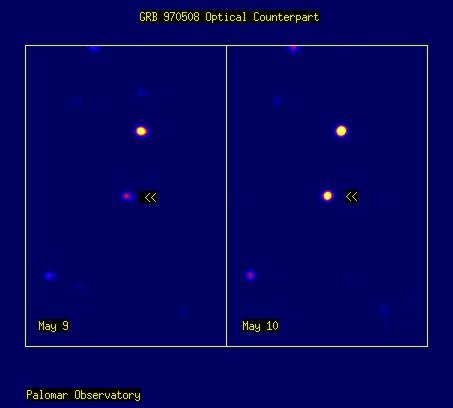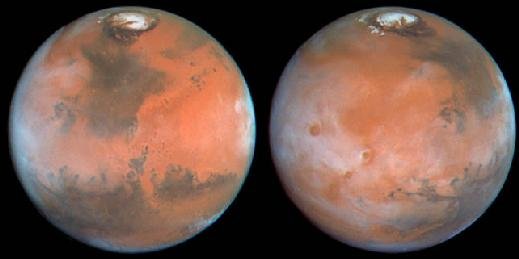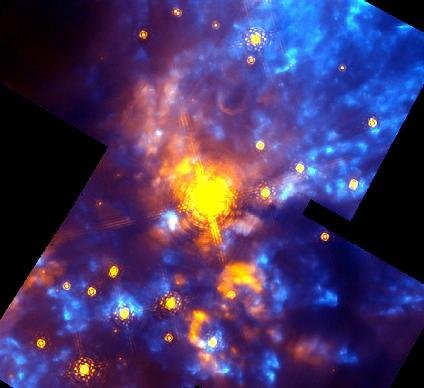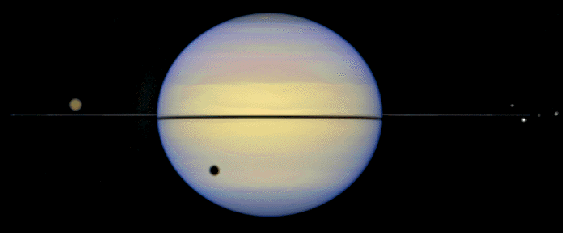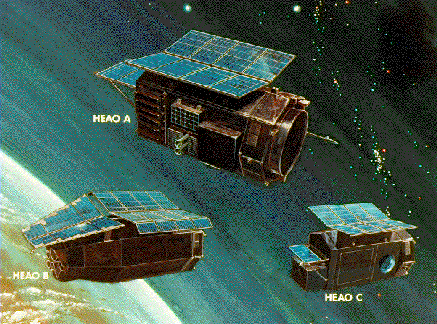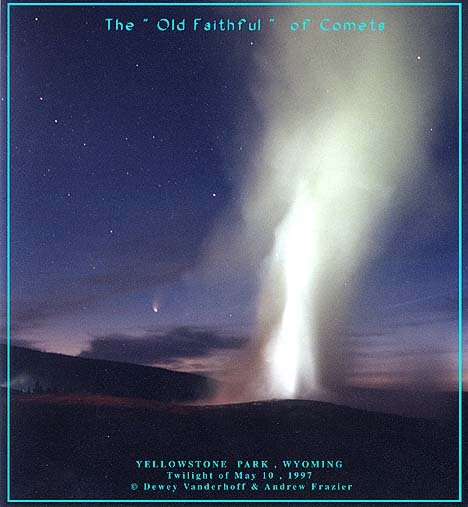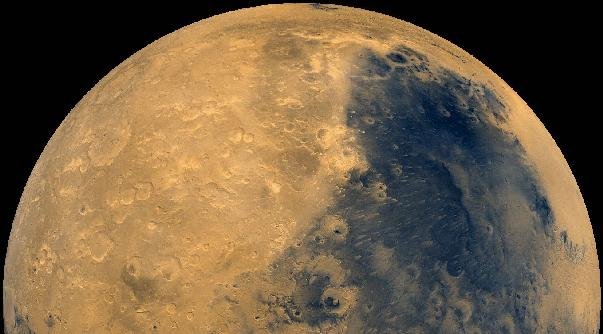NASA APOD #702-709
#702 GRB970508 Delivers Predicted Radio Emission May 21, 1997
“New evidence bolsters once controversial claims that Gamma-Ray Bursts (GRBs) are the most powerful explosions ever found by humanity. Two weeks ago, an average GRB became instantly historic when prompt, coincident X-ray and optical emissions were identified. The glow in visible light was particularly interesting because it showed color gaps indicative of absorbing gas at the very distant redshift of 0.8. If GRBs do occur this far into our universe, then radio emission was predicted to peak about a week after the optical emission. Now, late reports do indicate that radio emission has been detected and does peak a week later than the optical. This adds credibility to the claim that these bursts of gamma-radiation indeed occur far from our familiar home Galaxy. Shown above are two photos highlighting the changing optical emission from GRB970508 when it was increasing in brightness. Now light from this enigmatic explosion is fading."
Copyright: Public domain
#703 Bound For Mars May 22, 1997
“Two NASA spacecraft, Mars Global Surveyor and Mars Pathfinder, are presently approaching the red planet. Pathfinder is scheduled to land on July 4th and Global Surveyor due to enter orbit in September. Recent studies of the Martian climate, motivated by this impending invasion of spacecraft from Earth, have indicate that Mars weather is more chaotic than previously thought - showing abrupt swings between "hot and dusty" and "cold and cloudy". These Hubble Space Telescope images from March 1997 show the Northern Hemisphere in early Martian summer, with a receding polar cap and whitish water-ice clouds. The left image is centered on Ares Valles, Pathfinder's landing site, while in the right image, towering Tharsis mountains (massive extinct volcanoes) can be seen poking through the clouds. Stretching to the eastern edge of the righthand image (at lower right) is the Valles Marineris, an immense canyon system. Martian weather reports will play an important role in mission planning. Both spacecraft rely on the Martian atmosphere for braking maneuvers and Pathfinder's lander and rover are solar powered."
Copyright: Public domain
#704 The Heart Of Orion May 23, 1997
“Newborn stars lie at the heart of the Orion Nebula, hidden from view by the dust and gas of the giant Orion Molecular Cloud number 1 (OMC-1). Sensitive to invisible infrared wavelengths, Hubble's recently installed NICMOS camera can explore the interior of OMC-1 detecting the infrared radiation from infant star clusters and the interstellar dust and atoms energized by their intense starlight. In this false color picture, stars and the glowing dust clouds which also scatter the starlight appear yellowish orange while emission from hydrogen gas is blue. The dramatic image reveals a wealth of details, including many filaments and arcs of gas and dust -- evidence of violent motions stirred-up by the emerging stars. The bright object near the center is the massive young star "BN" (named for its discoverers Becklin and Neugebauer). The pattern of speckles and ripples surrounding BN and other bright stars are image artifacts."
Copyright: Public domain
#705 Saturn's Rings Seen Sideways May 24, 1997
“Saturn's rings are actually very thin. This picture from the Hubble Space Telescope was taken on August 6, 1995 when the rings lined up sideways as seen from Earth. Saturn's largest moon Titan is seen on the left, and Titan's shadow can be seen on Saturn's cloud tops! Titan itself looks a brownish color because of its thick atmosphere. Four other moon's of Saturn can be seen just above the ring plane, which are, from left to right: Mimas, Tethys, Janus, and Enceladus. If you look carefully, you will note that the dark band across the planet is actually the shadow of the rings, and is slightly displaced from the real rings - which are best seen away from the planet. Saturn's rings are not solid - they are composed of ice chunks which range in size from a grain of sand to a house."
Copyright: Public domain
#706 A High Energy Fleet May 25, 1997
“Looking like a fleet of futuristic starcruisers, NASA's highly successful series of High Energy Astrophysical Observatory (HEAO) spacecraft appear poised over planet Earth. Labeled A, B, and C in this vintage illustration, the spacebased telescopes were known as HEAO-1, HEAO-2, and HEAO-3 respectively. HEAO-1 and HEAO-2 were responsible for revealing to earthlings the wonders of the x-ray sky, discovering 1,000s of celestial sources of high-energy radiation. HEAO-2, also known as the Einstein Observatory, was launched near the date of the famous physicist's 100th birthday (November, 1978) and was the first large, fully imaging x-ray telescope in space. HEAO-3, the last in the series, was launched in 1979 and measured high energy cosmic-ray particles and gamma-rays. These satellite observatories were roughly 18 feet long and weighed about 7,000 pounds. Their missions completed, all have fallen from orbit and burned up harmessly in the atmosphere."
Copyright: Public domain
#707 Old Faithful Meets Hale-Bopp May 26, 1997
“As Comet Hale-Bopp leaves our Northern Skies, it provides us with yet another burst of joy. On May 11th the fading comet was photographed behind the famous "Old Faithful" water geyser of Yellowstone National Park, Wyoming, USA, Planet Earth. Perhaps more familiar to Earth Dwellers than the dark geysers on Neptune's moon Triton, the gas geysers on Jupiter's moon Io, and the dirty water geysers hypothesized on Jupiter's moon Europa, Earth's Old Faithful is also reliable - every 60-80 minutes it gushes a plume of water and steam high into the air. Comet Hale-Bopp will continue to be visible to observers in the Southern Hemisphere as it moves away from the Sun towards the outer Solar System."
Copyright: D.
Vanderhoff
#708 Moonrise, Planet Earth May 27, 1997
“During the Astro-1 astronomy mission of December, 1990, Space Shuttle astronauts photographed this stunning view of the full moon rising above the Earth's limb. In the foreground, towering clouds of condensing water vapor mark the extent of the troposphere, the lowest layer of the planet's life-sustaining atmosphere. Strongly scattering blue sunlight, the upper atmospheric layer, the stratosphere, fades dramatically to the black background of space. Moon and clouds are strong visual elements of many well known portraits of Planet Earth, including Ansel Adams' famous "Moonrise, Hernandez, New Mexico", photographed in November of 1941."
Copyright: Public domain
#709 Mars: Just The Fiction May 28, 1997
“For centuries, astronomers have observed Mars, patiently compiling many facts and theories. Like a distant mirror of Earth dwellers' hopes and fears for the future, Mars, the fourth planet from the sun, has inspired profound works of fiction as well. Classics of the science fiction genre with visions of Earth's alluring planetary neighbor include H.G. Wells' terrifying "War of the Worlds", Edgar Rice Buroughs' John Carter adventure series (Thuvia, Maid of Mars, The Gods of Mars, A Princess of Mars, The Warlord of Mars), Robert Heinlein's youthful "Podkayne of Mars", and Ray Bradbury's reflective and philosophical "The Martian Chronicles". Through the years scientific theories about Mars have been disproven, but the sense of wonder and adventure embodied in these works of fiction remain with us. As two spacecraft from Earth now draw close to the red planet- in dreams, desires, and a quest for knowledge - we are once again bound for Mars."
Copyright: Public domain
Upvote! Resteem! Comment! As you like it! Thank you for attention!
